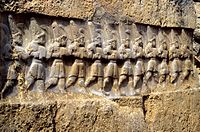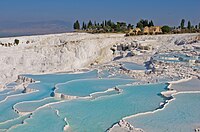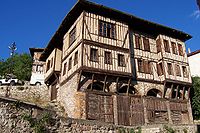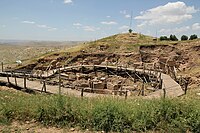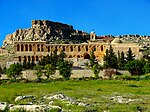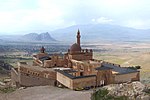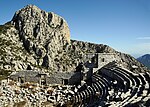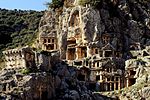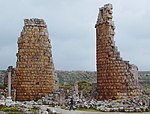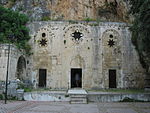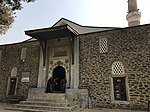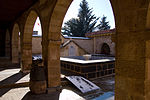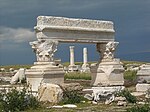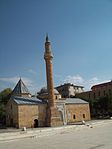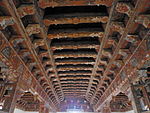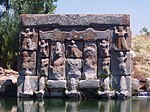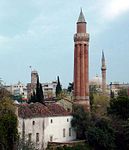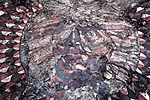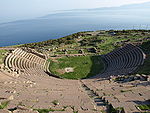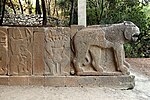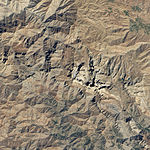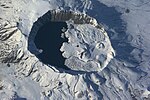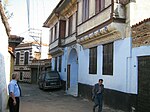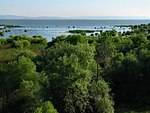World Heritage in Turkey
World Heritage Sites in Turkey |
The World Heritage in Turkey (as of 2018) includes 18 UNESCO World Heritage Sites , including 16 World Heritage Sites and two mixed cultural and natural heritage sites. The Turkey has ratified the World Heritage Convention in 1983, the first three World Heritage sites were inscribed on the World Heritage List 1985th
World heritage sites
The following table lists the UNESCO World Heritage Sites in Turkey in chronological order according to the year of their inclusion in the World Heritage List (K - cultural heritage, N - natural heritage, K / N - mixed, (R) - on the Red List of World Heritage in Danger ).
![]() Map with all coordinates of World Heritage Sites: OSM
Map with all coordinates of World Heritage Sites: OSM
| image | designation | year | Type | Ref. | description |
|---|---|---|---|---|---|
|
Historic areas of Istanbul ( location ) |
1985 | K | 356 | Due to its location on the Bosporus on two continents, the city of Istanbul is of great political, strategic and cultural importance. As a result of this and its function as the capital of the Byzantine Empire and the Ottoman Empire , numerous remarkable buildings were built. In addition to the old town, these include the Suleymaniye Mosque , the Sultan Ahmed Mosque , the Topkapı Palace , Hagia Sophia , the Chora Church and the Theodosian Wall . | |
|
Goreme National Park and rock monuments of Cappadocia ( location ) |
1985 | K / N | 357 | In the course of the early Christian settlement of Cappadocia , a large number of churches, apartments and entire underground cities were dug into the tuff rock as rock structures . | |
|
Divriği Great Mosque and Hospital ( location ) |
1985 | K | 358 | The Great Mosque and Hospital of Divriği, in Turkish Divriği Ulu Camii ve Darüşşifa , form a building complex in the small town of Divriği , which was built by a ruler of the Mengücek dynasty during the Seljuk period in Anatolia in 1228/29 . It is one of the most important medieval buildings in Anatolia | |
|
Hattusa ruins ( location ) |
1986 | K | 377 | Hattuša, near today's place Boğazkale , was in the 2nd millennium BC. The capital of the Hittite empire . In addition to numerous temples, fortifications and houses, the rock sanctuary of Yazılıkaya is part of it . | |
|
Monumental tomb on the Nemrut Dag ( location ) |
1987 | K | 448 | On the summit of Mount Nemrut Dağı near Adıyaman , the commagenic king Antiochus I built in the first century BC A sanctuary called Hierothesion for the royal cult established by him. His grave is suspected to be under the tumulus made of gravel stones . | |
| Ruins of Xanthos with the sanctuary of Latona | 1988 | K | 484 | The ancient city of Xanthos was the capital of the Lycian League in the second century BC . Together with the associated Letoon sanctuary , it has a large number of unique Lycian monuments. | |
| Hierapolis-Pamukkale ancient city | 1988 | K / N | 485 | The calcareous thermal springs of Pamukkale gave rise to the famous sintered limestone terraces . Nearby is the ancient Greek city of Hierapolis , which was known in ancient times for its warm springs. | |
| Safranbolu old town | 1994 | K | 614 | The houses, mosques, caravanserais and madrasas Safranbolus are exemplary of the architecture of the Ottoman Empire. | |
| Archaeological site of Troy | 1998 | K | 849 | The excavation site of ancient Troy, which consists of more than ten layers, is significant due to its more than 4,000 year history, as the scene of the Trojan War and also because of the excavations by Heinrich Schliemann , Wilhelm Dörpfeld , Carl Blegen and Manfred Korfmann . | |
| Selimiye Mosque in Edirne | 2011 | K | 1366 | The Ottoman Selimiye Mosque in Edirne includes a building complex with a medrese , a covered bazaar , clock tower and library. The architect Sinan called the building his masterpiece. | |
| Çatalhöyük Neolithic site | 2012 | K | 1405 | The Stone Age settlement near Konya existed from the 8th to the 6th millennium BC. And probably had up to 2500 inhabitants. | |
| Bursa and Cumalikizik: the cradle of the Ottoman Empire | 2014 | K | 1452 | With the graves of the first Ottoman sultans Osman I and Orhan I and numerous religious and secular buildings, Bursa and Cumalıkızık represent the emergence of the Ottoman Empire . | |
| Pergamon and its cultural landscape | 2014 | K | 1457 | The capital of the empire of the Hellenistic dynasty of the Attalids was a cultural and political center of antiquity with its library, monumental temples, grammar schools, theaters and the Asklepieion . | |
| Ephesus | 2015 | K | 1018 | Settled as early as the Hittite period, Ephesus was an important Roman city in which the apostle Paul also worked. It was the location of the Artemision , one of the seven wonders of the world . | |
| Diyarbakır Fortress and Hevsel Gardens Cultural Landscape | 2015 | K | 1488 | The castle and the city walls of Diyarbakır are among the largest and best preserved fortifications from ancient times. They were expanded to today's strength by the Roman emperor Constantius II in 349 . The Hevsel Gardens supply the city with vegetables and watermelons. | |
| Archaeological site of Ani | 2016 | K | 1518 | Ani is located on the Turkish-Armenian border and was the capital of the Armenian kingdom in the 10th century . It was considered the city of 1001 churches. The structures preserved in ruins are exemplary of medieval Armenian architecture. | |
| Aphrodisias | 2017 | K | 1519 | The ancient city of Aphrodisias was founded in the second century BC and was later the capital of the Roman province of Caria . In the extensive urban area, among many other well-preserved ruins, there are a temple of Aphrodite , a theater, a bouleuterion , a tetrapylon and a large stadium. | |
| Gobekli Tepe | 2018 | K | 1572 | The prehistoric site of Göbekli Tepe northeast of Şanlıurfa was discovered in 1963, but its importance was not recognized until 1994. The stone circles with T-shaped pillars, which are interpreted as stylized anthropomorphic steles, represent a Stone Age sanctuary. This oldest layer is dated to the 10th millennium BC, a time of hunters and gatherers . |
Tentative list
The sites that are intended for nomination for inclusion in the World Heritage List are entered in the tentative list .
Current World Heritage candidates
As of 2020, 83 sites are entered in the tentative list of Turkey, the last entry was made in 2020. The following table lists the sites in chronological order according to the year they were included in the tentative list.
![]() Map with all coordinates of current World Heritage candidates: OSM
Map with all coordinates of current World Heritage candidates: OSM
| image | designation | year | Type | Ref. | description |
|---|---|---|---|---|---|
|
Karain Cave ( location ) |
1994 | K | 666 | The stalactite cave near Antalya was inhabited from the Middle Paleolithic (about 200,000 years ago) through the Mesolithic (Middle Stone Age) to ancient times. | |
|
Sumela Monastery (Monastery of the Virgin Mary) ( Location ) |
2000 | K | 1397 | The Monastery of Our Lady of Sumela is a former Greek Orthodox monastery from Byzantine times in northeastern Turkey. | |
|
Alahan Monastery ( location ) |
2000 | K | 1398 | The monastery of Alahan is an early Byzantine ruins in the ancient mountainous landscape of Isauria above the valley of Kalykadnos . | |
|
St. Nicholas Church ( location ) |
2000 | K | 1399 | The Basilica of St. Nicholas in Myra (today Demre ) was built in the 6th century and was built by Emperor Constantine IX. and Empress Zoe expanded. | |
| Harran and Sanliurfa | 2000 | K | 1400 | Şanlıurfa or Urfa ( location ), the old Edessa, is considered the city of the prophets Job and Jethro , Abraham is said to have lived here. The old city of Harran ( Lage ) with its beehive houses is also mentioned in the Bible and is described as a travel and trading station as early as the ancient Babylonian period. | |
| Gravestones from Ahlat, the Urartian and Ottoman citadel | 2000 | K | 1401 | In the city of Ahlat, which dates from the time of the Urartian Empire , and its surroundings, there are cemeteries with tombstones and tombs from the 12th to 15th centuries. The proposal includes the six largest and most historically significant of these cemeteries. | |
| Seljuk caravanserais en route from Denizli to Doğubeyazıt | 2000 | K | 1403 | The Seljuk caravanserais , a type of architecture with social functions developed under the Qarakhanids and Ghaznavids in Central Asia, had a great influence on Anatolian architecture. There are about 40 of these caravanserais on the Denizli - Doğubeyazıt route . | |
| Konya - a capital of the Seljuk civilization | 2000 | K | 1404 | In the 12th and 13th centuries, Konya was the capital of the Seljuk Empire and an important cultural and political center. The buildings that were built during this period include the city fortifications, the Alaaddin Mosque, the Sirçali Medrese and numerous small mosques and turrets . | |
| Alanya | 2000 | K | 1405 | The peninsula of Alanya, the ancient Korakesion, has been inhabited since Hellenistic times and has many remarkable buildings, including the fortress with a Seljuk cistern, the sultan's palace of Kai Kobad I and a Seljuk bath and shipyard. | |
| Mardin Cultural Landscape | 2000 | K | 1406 | The medieval city of Mardin and its surroundings with the Tur Abdin mountains are exemplary for Anatolian landscape and architecture. The Zafaran Monastery is now the seat of the Syrian Orthodox Bishop of Mardin. | |
| Pauluskirche, Paulusbrunnen and the surrounding historical district | 2000 | K | 1409 | Tarsus is the birthplace of the apostle Paul and the meeting point of the legendary lovers Antonius and Cleopatra . The St. Paulus Church , which partly dates back to the 12th century, is the only preserved old church in the city. | |
| Ishak Pasha Palace | 2000 | K | 1410 | The Ishak Pasha Palace is located on the old Silk Road near the Iranian border. It was built between 1685 and 1784 and combines Seljuk, Armenian and Ottoman influences. | |
| Kekova | 2000 | K / N | 1411 | The region around the island of Kekova includes the Lycian cities Teimiussa, Simena , Aperlai and the ruins of a city that sank due to geological shifts in the sea. | |
|
Güllük-Dağı-Termessos National Park ( location ) |
2000 | K / N | 1412 | The city of Termessos , located at an altitude of 1050 meters on Solymos Mountain (today Güllük Dağı ), was mentioned in Homer's Iliad . The fortified city could not be conquered by either the Persians or Alexander the Great . In addition to the Güllük Dağı itself, the Mecine Gorge with rock walls up to 600 m high is one of the park's outstanding natural sites . | |
| Ancient cities of the Lycian civilization | 2009 | K | 5408 | The old region of Lycia in the south-west of the country was already in the 2nd millennium BC. Settled. It was called the Lukka Lands and was part of the Hittite Empire until the reign of Šuppiluliuma II . Lycians are mentioned in the Iliad , later they founded the Lycian League . These included the cities of Xanthos , Patara , Pinara , Tlos , Olympos , Myra , Limyra and others. Rock tombs are a typical feature of Lycian architecture . | |
| Archaeological site of Sagalassos | 2009 | K | 5409 | The region around Sagalassos was already in the 8th millennium BC. Populated by farmers. In Hittite text it is mentioned as Salawassa . At the time of Alexander the Great, the city was already one of the wealthiest in Pisidia . Even in Roman times, Sagalassos was still an important center. | |
| Archaeological site of Perge | 2009 | K | 5411 | Perge is in a Hittite treaty of 1235 BC. Mentioned as Parha . According to legend, Mopsos and Kalchas are considered to be the founders of the city after the Trojan War . In Roman times Perge was the capital of the province of Lycia et Pamphylia . | |
| Esrefoğlu Mosque | 2011 | K | 5611 | The Eşrefoğlu Mosque in Beyşehir was built in 1299 by Emir Süleyman Bey, the second Bey of the Eşrefoğulları . Well-preserved wooden pillars and other wooden parts of the building are remarkable. | |
| Hatay, St. Peter's Church | 2011 | K | 5613 | The St. Peter's Grotto is a cave church in Antakya in the province of Hatay , formerly Antioch on the Orontes . Legend has it that it served as a meeting place for the first Christian communities around Paul , Barnabas and Peter . | |
| Aizanoi ancient city | 2012 | K | 5724 | According to legend, the city of Aizanoi in Phrygia was founded by Arcadian settlers, but only became more important during the Roman Empire . During this period, the Temple of Zeus, the unusual combination of stadium and theater and a bridge over the city river Penkalas were built. | |
| Zeugma Archaeological Site | 2012 | K | 5726 | The Seleucid foundation of Zeugma on the Euphrates came in the 1st century BC. To the empire of Kommagene and was then border town of the Roman empire . During the emergency excavations due to the flooding of the city by the Birecik reservoir , numerous very well-preserved mosaics came to light, which are exhibited in the Zeugma Mosaic Museum built especially for this purpose . | |
| Gordion | 2012 | K | 5727 | The Acropolis and the upper town of the Phrygian capital Gordion were located on the settlement hill west of Ankara . Either King Midas or his predecessor Gordios was buried in the burial chamber in the Great Tumulus . | |
|
Birgi ( location ) |
2012 | K | 5728 | The city of Birgi in the historical region of Lydia , in what is now Ödemiş in western Turkey, was the capital of the Beyliks of Aydın in the 13th and 14th centuries . Relics from all periods from the Phrygian rule to the Ottoman era can be seen today. | |
|
Mausoleum and sacred area of Hekatomnos ( location ) |
2012 | K | 5729 | The mausoleum of the Carian ruler Hekatomnos and a temenos belonging to it were found on the Hisarbaşı hill in Milas in western Turkey in 2010 . | |
|
Medieval city of Beçin ( location ) |
2012 | K | 5730 | The city of Beçin already existed in Greek, Roman and Byzantine times. It gained importance in the second half of the 13th century as the capital of the Seljuk Beyliks of Mentesche . In addition to a fortress, numerous other buildings have been preserved in the city from this period. | |
| Historical monuments in Niğde | 2012 | K | 5731 | The Niğde Citadel with the Alaaddin Mosque, the Rahmaniye Mosque, the Sungur Bey Mosque, the covered bazaar and several churches can be found in the historic city center of Niğde . | |
| Yesemek quarry and sculptor's workshop | 2012 | K | 5732 | The sculpture workshop of Yesemek was v in the 14th century. Founded under Great King Šuppiluliuma I and lasted until the 8th century BC after an interruption at the end of the Hittite Empire. When the region came under Assyrian rule. Sculptures can be seen in all phases of their creation. | |
| Historic town center of Odunpazarı | 2012 | K | 5733 | Historical monuments from the Seljuk, Ottoman and Turkish times in Odunpazarı include the Alaaddin Mosque, the Kurşunlu Mosque complex and the Hacı Hasan Mosque. In addition to the workshops of traditional craftsmen and historic houses, the only Meerschaum museum in the world can be found there . | |
| Mamure Castle | 2012 | K | 5734 | The Mamure Kalesi fortress on the Mediterranean Sea in Cilicia is the best preserved castle on the Turkish south coast. It was built by the Romans in the 3rd or 4th century, later expanded by the Byzantines and Crusaders . After the end of the Kingdom of Lesser Armenia in 1375, the Karamanoğulları took possession of it. | |
| Hajji Bektash Veli Complex | 2012 | K | 5735 | The building complex in the Cappadocian city of Hacıbektaş includes a palace as well as the tomb of the mystic Haji Bektash Veli , the founder of the Bektashi- Derwish order. It is a place of pilgrimage for the Alevis . | |
| Archaeological site of Laodikeia | 2013 | K | 5823 | Laodikeia was an ancient city in Phrygia , near what is now Pamukkale . It was made between 261 and 253 BC. Founded by the Seleucid ruler Antiochus II and named after his wife Laodike . The visible monuments include a large stadium, two theaters, four baths, five agoras , a bouleuterion, as well as temples, residential houses, churches and other buildings. | |
| Special environmental protection area Tuz Lake | 2013 | N | 5824 | The Tuz Gölü salt lake covers an area of 164,200 hectares in spring and is on average 0.5 meters deep. It has no runoff and is mainly fed by precipitation and groundwater. In summer, a 30 centimeter thick layer of salt forms on the surface. Most of the Turkish greater flamingos nest here.
|
|
| The ancient city of Sardis and the Lydian burial mounds of Bin Tepe | 2013 | K | 5829 | The city of Sardis was the capital of the Kingdom of Lydia and thus the seat of well-known kings such as Gyges and Kroisos . Notable buildings include the Temple of Artemis from the Greek period and the grammar school and synagogue from Roman times . To the north of it, on the southern shore of Lake Marmara Gölü, lies the Bin Tepe Bin Tepe necropolis with over a hundred Lydian tumuli . The largest is the grave of Alyattes II with a diameter of 355 m and a height of 35 m . | |
| İznik | 2014 | K | 5900 | İznik , the ancient Nikaia (Nicäa) was founded around 300 BC. Founded by Lysimachus . It became famous in late antiquity through the First and Second Councils of Nicaea . In 1077 the Rum Seljuks conquered the city and established their first capital. After the conquest of Constantinople by the Crusaders in 1204, the Byzantines who withdrew from there founded the Empire of Nikaia , which existed until the reconquest of Constantinople in 1261. In Ottoman times, the city was known for its tile production ( İznik ware ). | |
| Zeynel Abidin Mosque Complex and Mor Jakup Church | 2014 | K | 5901 | The Mor Jakup Church, dedicated to Jacob von Nisibis , and the Zeynel Abidin Mosque with the associated building complex in Nusaybin , ancient Nisibis , are evidence of centuries of coexistence between different religions in the region near the Syrian border. | |
| Tomb of Ahi Evran | K | 5902 | Ahi Evran was an Islamic preacher and philosopher in the 12th and 13th centuries and is the patron saint of tanners and other leather craftsmen. 13 more graves of his successors are grouped around his Türbe in Kırşehir . | ||
| Vespasian Titus tunnel | 2014 | K | 5903 | In order to avoid the annual flooding of the city of Seleukia Pieria , near today's Samandağ in the southeast Turkish province of Hatay , and the port from meltwater, the Roman Emperor Vespasian had a diversion system built in the 1st century AD, consisting of a dam and two tunnels - and three canal sections, a total of 875 meters long. The construction was continued by his son Titus and completed in the 2nd century under Antoninus Pius . | |
| Mahmut Bey Mosque | 2014 | K | 5904 | The Mahmut Bey Mosque in the village of Kasaba near Kastamonu was built in 1366 by Mahmut Bey, a ruler of Candaroğlu Beylik . It is one of the first mosques in Turkey with wooden pillars and a wooden roof. | |
| Kültepe-Kaniš archaeological site | 2014 | K | 5905 | The town of Kaniš on a hill near Kayseri was inhabited since the early Bronze Age. The associated lower town was one of the Assyrian trading posts called karum in Anatolia at the beginning of the 2nd millennium BC. There archives with over 20,000 cuneiform tablets in the ancient Assyrian language were excavated. | |
| Ancient city of Kaunos | 2014 | K | 5906 | Kaunos near today's Dalyan in southwest Turkey was on the border of the historical regions of Caria and Lycia . The visible relics from Hellenistic and later times include a theater, temple, a palaestra , baths and, above all, impressive rock tombs . | |
| Anatolian Seljuks madrasas | 2014 | K | 5907 | The Seljuk madrasas in Anatolia were primarily built as Muslim religious schools in the 12th and 13th centuries, but occasionally also included hospitals and observatories. Following the Persian model, they have an ivan on each side, an open or covered courtyard, cells for the students and the actual classrooms. Buildings in Konya , Kayseri , Sivas , Erzurum and Kirşehir are noteworthy . | |
| Arslantepe Archaeological Site | 2014 | K | 5908 | The settlement hill Arslantepein of the plain of Malatya was since the 6th millennium BC. Inhabited until the Neo-Hittite and Roman times. Particularly noteworthy is a 2000 m² complex of adobe architecture from the first half of the 4th millennium BC, called a palace. BC, where the first swords made of arsenic bronze were found. | |
| Ancient city of Korykos | 2014 | K | 5909 | The area of the Cilician city of Korykos is located near the current seaside resort of Kızkalesi on the Mediterranean coast. It includes a land and a sea fortress that were once connected by a dam. This also includes at least twelve churches and extensive necropolises with rock tombs and sarcophagi . The ruins of numerous settlements from Hellenistic to early Christian times are in the vicinity. | |
| Ancient city of Anazarbos | 2014 | K | 5910 | The ancient city of Anazarbos is located near the village of Dilekkaya in Cilicia . It was the center of the empire of the former pirate Tarkondimotos I , who had been appointed king by Pompey after his victory over the pirates. An impressive medieval castle rises above the city level with a triumphal arch , theaters, temples, colonnaded streets, sarcophagi and chamosoria . | |
| Çanakkale (Dardanelles) and Gelibolu (Gallipoli), battle sites of the First World War | 2014 | K | 5911 | The Gallipoli peninsula (Turkish Gelibolu Yarımadası ) on the European side of the Dardanelles (Turkish Çanakkale Boğazı ) was attacked in 1915 in the Battle of Gallipoli, initially by sea and later by a land invasion. During the fighting between Ottoman forces on the one hand and British, French and Australian troops on the other hand, the attack was stopped with the help of Mustafa Kemal Pascha . Several memorials on both sides testify to the fighting today. | |
| Eflatun Pinar: The Hittite spring sanctuary | 2014 | K | 5912 | With Eflatun Pınar (purple source) a 7 meter wide and 4.2 meter high façade sculptures is known that at a source pond near the lake Beyşehir Gölü stands. The sanctuary dates from the time of the Hittite Empire between the 15th and 13th centuries BC. Represented are members of the Hittite pantheon , in the center the weather god with the sun goddess of the earth , including mountain gods and various hybrid beings, all crowned by a winged sun disk. | |
| Akdamar Church | 2015 | K | 6035 | on Akdamar Island in Lake Van | |
| Theater and aqueducts of the ancient city of Aspendos | 2015 | K | 6036 | ||
| Eshab-ı Kehf Kulliye (Islamic-Ottoman Social Complex) | 2015 | K | 6037 | Külliye in Afşin | |
| Historical guild town of Mudurnu | 2015 | K | 6038 | ||
| Harşena Mountain and the rock tombs of the Pontic kings | 2015 | K | 6039 | The Harşena Dağı is a 272-meter-high mountain in the town of Amasya on the river Yesilirmak . In its southern rock face are rock tombs for the kings of the kingdom of Pontus . | |
| Mountainous Phrygia | 2015 | K | 6040 | Already proposed in 1984 as " Phrygian rock monuments ( Kırka , Arslankaya , Aslantaş and Yılantaş , Maltaş , Arezastis etc.)" | |
| Stratonikeia ancient city | 2015 | K | 6041 | ||
| Uzunköprü Bridge | 2015 | K | 6042 | The "Long Bridge" (Turkish Uzun köprü), which gave its name to the town of Uzunköprü , is the longest preserved stone bridge in the world at 1,392 meters. It was built from 1427 to 1443 under the Ottoman Sultan Murad II across the Ergene River south of Edirne . | |
| Tomb of Ismail Fakirullah and its light deflection mechanism | 2015 | K | 6043 | Tomb of Ismail Fakirullah in the city of Tillo with a tower from which a hidden reflector reflects the light of the rising sun on the cenotaph of Ismail Fakirullah on March 21 ( Nouruz ) and September 23 | |
| Yıldız Palace Complex | 2015 | K | 6044 | Palace complex in Istanbul | |
| Malabadi Bridge | 2016 | K | 6113 | Stone arch bridge from the 12th century over the Batman Çayı near the town of Silvan | |

|
Tušpa / Van fortress, the mountain and old town of Van | 2016 | K | 6114 | |

|
Sultan Bayezid II Complex : A center of medical treatment | 2016 | K | 6117 | |
| Yivli Minare Mosque | 2016 | K | 6119 | ||
| Great Mosque of Sivrihisar | 2016 | K | 6120 | in Sivrihisar | |
| Bodrum Castle | 2016 | K | 6121 | ||
| Nuruosmaniye complex | 2016 | K | 6122 | ||
| Kibyra ancient city | 2016 | K | 6123 | ||
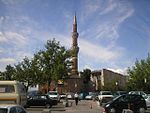
|
Hacı Bayram Mosque and its Surroundings (The Hacıbayram District) | 2016 | K | 6124 | |
|
|
Kızılırmak -Delta wetland and bird sanctuary | 2016 | N | 6125 | |
| Archaeological site of Assos | 2017 | K | 6242 | Assos is an ancient city on the Mediterranean coast. | |
| Ayvalık industrial landscape | 2017 | K | 6243 | ||
| Cultural landscape of İvriz | 2017 | K | 6244 | ||
| Early Period of Anatolian Turkish Heritage: Niksar, the capital of the Danish Menden dynasty | 2018 | K | 6344 | ||
| Underground hydraulic structures in Gaziantep: Livas' and Kastels | 2018 | K | 6345 | Livas (underground water tunnels ) and Kastels (fully or partially underground structures), where the water supplied by the Livas' is made available for public use, in the southeast Anatolian city of Gaziantep | |
| Wooden roof and wooden beams of mosques in Anatolia | 2018 | K | 6346 | The proposal includes: the Eşrefoğlu Mosque , Mahmut Bey Mosque (has been on the tentative list as a separate entry since 2014), Sivrihisar Grand Mosque, Afyon Grand Mosque and the Arslanhane Mosque | |
| Justinians Bridge | 2018 | K | 6347 |
|
|
| Archaeological site of Priene | 2018 | K | 6348 | Was already on the tentative list from 1984–1996.
|
|
| Historic city of Harput | 2018 | K | 6349 | ||
| Basilica Therma (Sarıkaya Roma Hamamı) | 2018 | K | 6350 | ||
| Ballıca Cave Natural Park | 2019 | K | 6403 | ||
| Historic city of Beypazarı | 2020 | K | 6469 | ||
| Karatepe-Aslantaş archaeological site | 2020 | K | 6470 | ||
| Koramaz river valley | 2020 | K | 6473 | ||
| Historic port city of Izmir | 2020 | K | 6471 | ||
| Trading posts and fortresses on Genoese trade routes from the Mediterranean to the Black Sea | 2020 | K | 6468 | Has been on the tentative list since 2013. The planned transnational nomination of Genoese colonies in the former Genoese territory between the Mediterranean and the Black Sea in Turkey includes six fortresses Akcakoca , Amasra , Çandarlı , Foca , Sinop and Yoros and the Galata Tower in Istanbul .
Other proposals were submitted by Ukraine (Ref. 5575 ). |
|
| Zerzevan Castle and Mithraeum | 2020 | K | 6472 |
Former World Heritage candidates
These sites were previously on the tentative list, but were withdrawn or rejected by UNESCO. Sites that are included in other entries on the tentative list or that are part of world heritage sites are not taken into account here.
![]() Map with all coordinates of former World Heritage candidates: OSM
Map with all coordinates of former World Heritage candidates: OSM
| image | designation | year | Type | Ref. | description |
|---|---|---|---|---|---|
| Antakya | 1984-1985 | K | The present-day city of Antakya is located on the site of the ancient metropolis Antioch on the Orontes , which in Roman times was one of the largest and most important cities in the eastern Mediterranean along with the Egyptian Alexandria and (later) Constantinople .
In 2011, the local St. Peter's Grotto was added to the World Heritage List. |
||
|
Didyma Temple of Apollo ( location ) |
1984-1996 | K | Hellenistic temple complex, important oracle site of the god Apollo | ||
|
Beydağları Coastal National Park ( location ) |
1984-1996 | K / N | also called Olympos-Beydağları National Park | ||
| Waldrapp sanctuary in Birecik ( location ) |
1984-1996 | N | Protected area with a free population of the ibis species Waldrapp on a cliff in the middle of the town of Birecik | ||
|
Cilo Sat Mountains ( location ) |
1984-1996 | N | Mountain range named with the Uludoruk and the Cilo Dağı , the second and third highest mountain in Turkey | ||
|
Nemrut Dağı Crater ( location ) |
1984-1996 | N | |||
| Dilek Yarimadasi National Park | 1984-1996 | N | |||
| Eğirdir Nature Reserve | 1984-1996 | N | Sanctuary for Quercus vulcanica - | ||
| Güven - fish and insect fossils | 1984-1996 | N | |||
| Halicarnassus | 1984-1996 | K | |||
| Bosphorus in Istanbul | 1984-1996 | K | " Istanbul Historic Places " was added to the World Heritage List in 1985. | ||
| Karatepe-Arslantaş National Park | 1984-1996 | K | |||
| Kula - a typical Ottoman town near Manisa | 1984-1996 | K | |||
| Kuşcenneti National Park | 1984-1996 | N | |||
| Köprülü Kanyon National Park | 1984-1996 | K / N | |||
| Köyceğiz Nature Reserve | 1984-1996 | N | Protected area for the oriental sweetgum tree ( Liquidambar orientalis ) | ||
| Marmaris - Gokova | 1984-1996 | K | comprised the coastal town of Marmaris and the municipality of Gökova , located about 20 km north of this | ||
| Pit, maar and travertine conoids in Konya | 1984-1996 | N |
|
||
| Salihli - fossil human footsteps | 1984-1996 | K | |||
| Sultansazlığı National Park | 1984-1996 | N | |||
| Old town of Van and Lake Van | 1984-1996 | K | includes the historic center of the eastern Anatolian city of Van and the adjacent Lake Van | ||
| Yedigöller National Park | 1984-1996 | N |
Web links
- Turkey on the UNESCO World Heritage Center website.
Individual evidence
- ↑ Turkey. In: whc.unesco.org. UNESCO World Heritage Center, accessed March 3, 2018 .
- ↑ German names according to the World Heritage List. In: www.unesco.de. German UNESCO Commission, accessed on January 20, 2018 .
- ^ Tentative list of Turkey. In: whc.unesco.org. UNESCO World Heritage Center, accessed March 3, 2018 .
- ^ Former Tentative Sites of Turkey. In: World Heritage Site. Retrieved March 3, 2018 .




